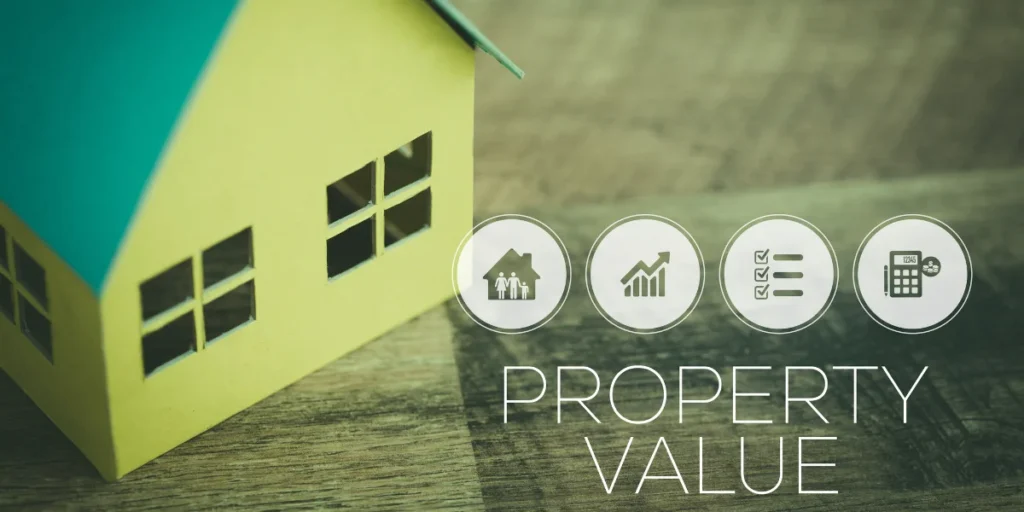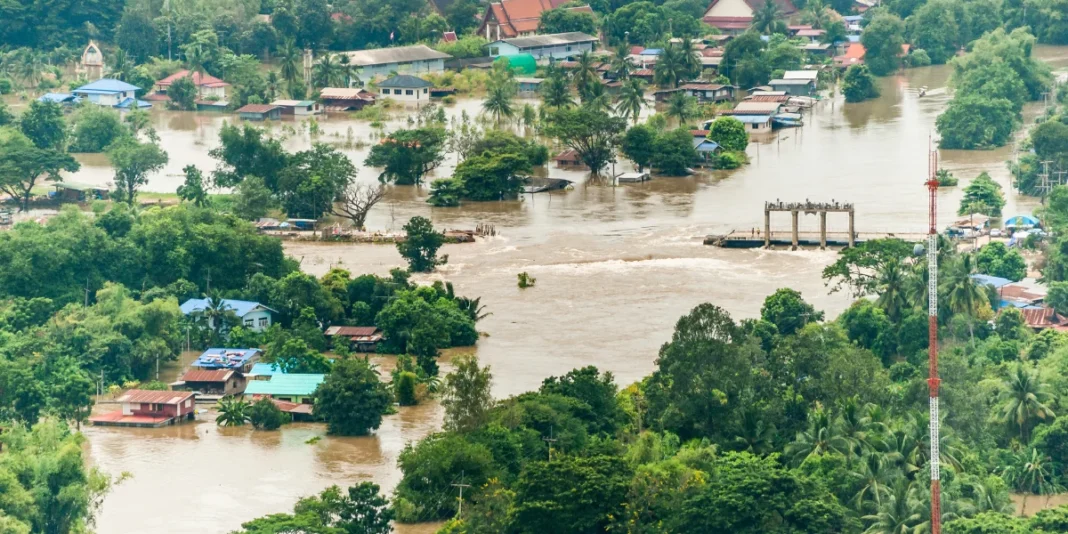Flood risk property values in Australia have suffered a staggering $42.2 billion loss due to climate-related flooding, with one in six homes across the country now affected by this growing crisis. Currently, more than two million dwellings are located in mapped flood zones, experiencing varying levels of risk that directly impact their market value. Consequently, the typical three-bedroom house in a flood-prone area is valued approximately $75,500 less than comparable homes in flood-free locations.
While property values throughout Australia have risen significantly since 2000, the gap between flood-prone and flood-free properties continues to widen. Indeed, flood-affected properties have recorded cumulative price growth of 394% compared to 416% for flood-free properties—a notable 22 percentage point difference nationally. This disparity clearly demonstrates how flood risk is capitalised into property values, with at least 70% of flood-prone properties experiencing devaluation. Furthermore, the property value report highlights that even prestigious areas aren’t immune, with high-value coastal and inner-city communities sometimes losing more than half a million dollars per flood-prone home compared to nearby properties not at risk.
Flood Risk Reduces Property Values By $42.2 Billion

The financial impact of flooding on Australian real estate extends far beyond property damage, with mapped flood zones creating a permanent devaluation across housing markets. A comprehensive analysis of more than 20 years of property data reveals the economic toll of flood risk on home values nationwide.
One in Six Homes Affected
Throughout the country, approximately two million homes—roughly one in six properties—are located in mapped flood zones. Of these flood-exposed properties, about 70% have experienced a reduction in their market value. The geographic distribution of this burden is uneven, with Queensland carrying the heaviest load—about 803,000 homes, representing a third of the state’s housing stock, face flood risk. NSW follows with almost 604,000 properties (16% of state housing) in flood-prone areas, Victoria with 255,704 homes (8.7%), and South Australia with 19.6% of its housing affected.
A Typical Home Loses $75,500 in Value
The value gap between flood-prone and flood-free properties is substantial. According to the PropTrack Climate Council Property Value Flood Risk Report, a typical three-bedroom, two-bathroom house in a flood zone is worth approximately $75,500 less than a comparable property outside the risk area. This discount varies considerably by location, however. In Brisbane’s riverside suburbs of Chelmer and Graceville, flood-prone houses have lost 10.6% of their value—around $463,284 per property. Similarly, homes in western Sydney’s Hawkesbury catchment area are worth $555,787 less than equivalent properties without flood risk, representing an 8.7% reduction.
Do Property Values Reflect Flood Risk?
Economic theory suggests that properties located within floodplains should suffer a price discount. Despite this, actual market behaviour shows inconsistent capitalisation of flood risk. A meta-analysis of 37 published studies found that properties in inland flood zones typically experience a price discount of approximately 4.6%. Moreover, the national data show that flood-prone properties have recorded cumulative price growth of 394% since 2000, versus 416% for flood-free properties—a 22 percentage point difference.
Nevertheless, about 30% of properties in flood zones show no reduction in value. This anomaly occurs primarily in areas where buyers prioritise water views or lifestyle benefits over potential flood hazards. Additionally, high-value areas with flood exposure are experiencing notable price increases as market awareness grows.
Queensland and NSW
Two Australian states bear the majority of the property devaluation resulting from flood risk, with Queensland and New South Wales accounting for approximately 70% of the nationwide impact. Of the properties facing flood threats, 40% are located in Queensland, and 30% are located in New South Wales.
Gold Coast and Brisbane Suburbs
The financial toll in Queensland is especially severe, with flood-related value foregone exceeding $29 billion as of April 2025. Across the state, about 803,000 properties—representing one-third of all Queensland homes—are situated in flood zones. The Gold Coast ranks as the most affected region, with a collective loss of $6.88 billion in value. Primarily, the impact extends to Brisbane’s riverside areas, which have experienced ten major flood events since 2010.
Lismore and Chelmer
Brisbane’s Chelmer-Graceville area has suffered the nation’s most significant penalty for flood-prone homes, with values reduced by 10.6%—equivalent to approximately $463,284 per property. In northern New South Wales, Lismore’s property market demonstrates how recent disasters reshape values. Following record-breaking floods in 2022, when waters rose 14.4 metres, flood-prone Lismore homes remain more than 20% below their early 2022 values. Overall, NSW properties have forgone around $21.41 billion in value.
High-Value Areas Risk Devaluation
Even prestigious locations face substantial devaluation when flood risk is present. For instance, homes in Mermaid Beach and Broadbeach on the Gold Coast experience a 48% reduction in value when located in flood zones, despite the fact that only 16% of houses there face a flood risk. This represents a striking average loss of $2.60 million per affected property. Likewise, properties in NSW’s upmarket areas of Bellevue Hill and Balmain have shown substantial dollar value losses.
Yet paradoxically, in specific premium markets such as Noosaville and Noosa Heads on the Sunshine Coast, waterfront properties actually command higher prices than comparable flood-free homes. As real estate agent Shane McCauley notes, “Flood risk wasn’t on the radar for most buyers in the Noosa region, who were more focused on the benefits of the waterside position rather than potential drawbacks”.
Market Behaviour Reveals Uneven Risk Perception

Across Australian property markets, the actual impact of flood risk reveals a complex pattern of buyer behaviour. Analysis of two decades of property data reveals uneven risk perception, which varies significantly by location, price point, and recent flood history.
Flood-Prone Homes Rising
Although values of flood-prone homes continue to increase over time, they typically do so from a lower base and at a reduced pace. Nationally, the price growth gap between flood-prone and flood-free homes has reached 22 percentage points since 2000. This creates a compounding effect, where affected homeowners accumulate less equity despite rising market values.
Buyers Trade Affordability For Risk
In today’s challenging affordability landscape, some buyers deliberately choose flood-prone properties for their lower entry prices. As Charles Wiggett of Hauss Realty notes, “People were still prepared to buy homes with a flood-risk because of their affordability—particularly investors”. Primarily, this trend affects low-income families, with more than half of flood-prone properties owned or rented by these households.
Lifestyle Appeal Offsets Risks
Interestingly, about 30% of mapped flood-zone properties show no price discount. This occurs mostly in premium locations where coastal views and beachside lifestyle outweigh flood concerns. For instance, houses in flood zones within Noosaville, Noosa Heads, and Hope Island typically command higher prices than comparable risk-free homes.
Flood Events Reshape Buyer Sentiment
Major flood disasters fundamentally alter market perceptions. Following the record 2022 floods in Lismore, the gap between at-risk and flood-free homes widened by 21 percentage points. Essentially, price impacts appear to be shaped by perceived vulnerability, with recent disasters having a greater market impact than their statistical likelihood of occurrence would suggest.
Resilience Investment Offers Economic Upside

Beyond the losses, flood risk presents a substantial economic opportunity through targeted investment in resilience infrastructure. Experts note that each dollar invested in flood protection can deliver multiple dollars in benefits, converting potential devaluation into preserved property value.
Flood Prevention Infrastructure Restores Value
Investment in flood defence infrastructure offers remarkable returns, with some projects yielding benefit-to-cost ratios as high as 120—meaning every dollar invested generates up to $183.48 in benefits. Through flood levees, drainage improvements, and stormwater upgrades, billions in unrealised property value could be restored. Conversely, without intervention, insurers warn that premiums may rise enough to reduce property values by as much as 10%.
Planning Reform To Prevent Future Losses
Currently, many homes are located in direct paths of flooding because planning approvals did not adequately account for the risks of extreme weather. Given that land use planning is divided between state and local governments, complicating consistent approaches, reforms could reduce unnecessary exposure to risk. Victoria has already begun implementing new flood risk tools and standardised planning controls.
The Report Backs Climate Adaption
The property value findings reinforce Australia’s National Adaptation Plan, which allocates approximately $13.76 billion through 2030 for resilience measures. Notably, early identification of high-risk areas would enable more accurate credit pricing, guide targeted adaptation investments, and inform zoning reform.
Conclusion – Flood Risk Property Values
Flood risk has fundamentally altered Australia’s property landscape, creating a $42.2 billion value gap between flood-prone and flood-free homes. Throughout the country, the evidence shows this impact varies dramatically by location, with Queensland and New South Wales shouldering approximately 70% of nationwide losses. Meanwhile, premium locations such as Mermaid Beach face devaluations exceeding $2.6 million per affected property, demonstrating that even prestigious areas remain vulnerable to devaluation.
Nevertheless, market behaviour reveals surprising inconsistencies in risk perception. Despite clear economic disadvantages, roughly 30% of flood-prone properties maintain values comparable to their flood-free counterparts—particularly where lifestyle benefits outweigh perceived risks. Additionally, affordability pressures drive some buyers to deliberately accept flood exposure for lower entry prices, though this trend disproportionately affects lower-income households.
Property data spanning two decades clearly establishes that flood risk has created a 22 percentage point growth gap between properties affected and those unaffected. This difference compounds over time, significantly reducing wealth accumulation for owners in flood zones. Consequently, housing markets are increasingly reflecting climate risk, although recent flood events appear to accelerate market adjustments far more effectively than statistical probabilities alone would suggest.
Climate change will undoubtedly intensify flooding threats across Australia. Therefore, forward-thinking policy approaches must strike a balance between property market stability and realistic risk assessments. Without coordinated action, the $42.2 billion valuation gap may represent merely the beginning of a much larger economic reckoning—one that transforms not just property values but entire communities across flood-vulnerable regions.
You May Also Be Interested In: Property Flipping Made Simple: Your Step-by-Step Guide to Smart Investment
How much has flood risk reduced property values in Australia?
Flood risk has reduced property values in Australia by approximately $42.2 billion. This affects about one in six homes across the country, with the typical flood-prone home losing around $75,500 in value compared to similar properties in flood-free areas.
Which Australian states are most affected by flood-related property devaluation?
Queensland and New South Wales are the most affected states, accounting for about 70% of the nationwide impact. Queensland has over 803,000 properties at risk, while New South Wales has approximately 604,000 flood-prone properties.
Do all flood-prone properties experience a decrease in value?
No, not all flood-prone properties experience a decrease in value. About 30% of properties in flood zones show no reduction in value, particularly in areas where buyers prioritise water views or lifestyle benefits over potential flood hazards.
How do recent flood events impact property values?
Recent flood events can significantly reshape buyer sentiment and property values. For example, following the record 2022 floods in Lismore, the gap between at-risk and flood-free homes widened by 21 percentage points, demonstrating how major disasters can alter market perceptions more than statistical flood probabilities.






